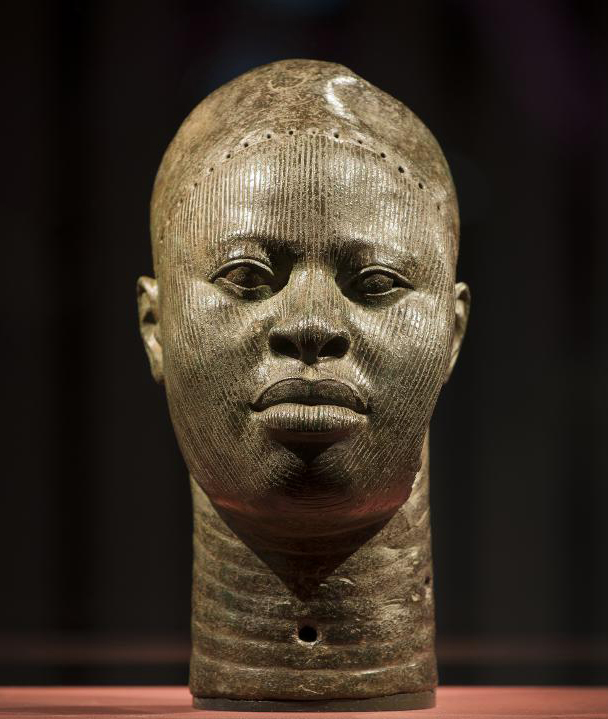An Overview of African Art History through Time

The history and culture of the globe have been significantly influenced by African art. The idea that Africa is the origin of human history is practically unassailable.
African art history has roots that date back well before written history and have been maintained through the ages.
Rock art dates back hundreds of years, while 75 000-year-old shell beads made into a necklace have been found in a cave in the southernmost region of South Africa.
According to research on the development of African art, the earliest sculptures discovered date back to 500 BC and are from Nigeria.
However, the absence of archaeological digs hinders understanding of the age of African art, and the fact that the materials used to make art objects are purely disposable means that an untold number of things have vanished throughout the course of history.
This is exacerbated worse by the fact that no attempt was made to preserve these artifacts since the indigenous cultures that produced them did not see them as aesthetic achievements. Once their purpose was fulfilled, their worth was frequently little.
Beginning in 1840, most of the nations in sub-Saharan Africa underwent foreign colonization, which resulted in the spread of various ideals.
In the century prior, travelers, traders, and missionaries purchased a significant amount of African art for amusing purposes before leaving the region.
Because colonialists frequently failed to recognize and value local art, African art history was rarely preserved or recorded.

Central African art history
Central African art history has received a lot of attention for two reasons: first, the communities that lived there were among the most sedentary tribes in Africa, and second, they produced figurative sculptures that Western collectors could most readily recognize as “art” according to their definition.
The human figure serves as the primary topic, and strong formal aspects and powerful design elements were demonstrated to create balance and harmony.
These formal design characteristics, along with a potent spirituality and expressive fervor, drove artists to experiment with new dynamics in visual art in the early 20th century and served as the cornerstone for contemporary abstraction.
The spike in interest in tribal and modern African art as collectibles have compelled academics, investors, governments, and organizations to reconsider the very nature of African art.
In order to observe and appreciate African art history collections as the beautiful and intriguing field of art that it is, they have been brought to the front of museums, galleries, and auction houses.
Researchers from Europe and Africa are analyzing collections to help revive forgotten crafts and traditions from the civilizations they originated from as well as to learn more about the history of African art.
Only practical items would have been transported in the past because certain civilizations weren’t sedentary and would have carried as little as possible.
They would have been abandoned if their purpose had ceased to serve the creator and his society since their worth was founded on their practicality and their spiritual qualities.
Uncountable works of art that would have been abandoned on the side of a wandering existence must have been lost in Africa.
Also Read: Ancient Civilizations of Africa and African Empire
Earliest examples of African art history
The earliest type of art in Africa is called rock art.
According to research on human evolution, contemporary Homo Sapiens originated in Africa. Therefore, it seems to sense that Africa would have the oldest and most extensive collection of rock art on the globe.
Although most experts believe that Africa’s rock art may date to more than 50,000 years ago, the earliest pictures that have been properly dated are in Namibia (the Apollo 11 caves), where they date to between 24 and 27,000 years ago.
In the Saharan dunes of Niger, the earliest known rock art was created about 6500 BC. They are sculptures called petroglyphs that show extinct creatures like giraffes from that region.
These pictures reveal how prehistoric tribes and cultures perceived the world around them. We may learn about the artists’ thoughts, as well as their spiritual and material worlds, by studying their works.
Unfortunately, a large portion of this priceless history is being lost, either naturally as a result of human pressure on the locations or as a result of graffiti defacing the rock paintings.
We must figure out a method to conserve the global treasure that African art history represents.
Sculptures
Nok Culture
The magnificent terracotta ceramic heads from the Nok culture of Nigeria, most of which are pieces of figures, are the oldest sculptures that have been discovered. They range in period from 500 BC to 200 AD.
They show that powerful abstract figural representation has been present in Africa for more than 2500 years and is formed of grog and iron-rich clay, although none of them have been discovered in their native contexts.
This marked the beginning of the African sculptural tradition due to their strong formal features and emotive qualities.
Nok art stands out for its sense of caricature and a strong sense of fashion, which is seen in its extravagant hairstyles and adornment.
Currently, Nok terracottas hold a significant but solitary place in the history of African art.
Sokoto
Figures of an unusual harshness are being made in the Sokoto area of northwestern Nigeria by the first century AD.
At the intersection of several historic trade routes sits Sokoto. Even while we haven’t fully understood the relationship between the two seemingly disparate civilizations.
It is certain that these figures have a connection to Nok figures, despite having thicker brows and being less decorated.
The burnt clay ware Lydenburg heads, the earliest known African artworks south of the equator, were discovered in the same South African area of the same name. It has been determined that they have buried there about 500 AD.
Although little is known about the ancient society that produced this collection of seven heads, their careful burial demonstrates the importance and regard they had for the people who placed them under the earth.
Large rings with furrows surrounding them may denote wealth and power, although it is impossible to know for sure. We can only make educated guesses and put them in the framework of what we know about the history of African art.
Ile-Ife
Archaeologists have discovered terracotta sculptures that date from 1000 to 1300 AD in the Ife region of Nigeria and the Jenne region of Mali.
Throughout Africa throughout the 19th and 20th centuries, impressive terracotta sculptures were still produced.
There are stone carvings from Sierra Leone’s Sherbro and Kongo tribes that date to no later than the 16th century.
Benin also produced highly skilled ivory carvers at the same period.
The only other material that can endure the termites on the continent is cast metal. The Igbo-Ukwu tribe of Nigeria has a bronze-casting heritage that dates to the ninth century AD.
Sites have turned up cast bronze regalia and other pieces of artwork.
The Ife people of Yoruba, Nigeria, who started making extremely good brass and bronze castings in the 12th century and were doing so until the 15th, are credited with carrying on this magnificent heritage to its pinnacle.
Amazing realism was attained by life-size heads, masks, and smaller full-length figures, and they all conveyed a calm intensity that was the precursor to that character that we now so highly value in traditional African sculpture.
They are occasionally also cast in pure copper, which is technically much more difficult than brass.
Benin
From the 15th century till the present, the Yoruba people of Benin carved heads that are now known as Benin bronzes but are actually constructed of brass that was brought over on the trade route in the shape of vessels and decorations and melted down.
Both of these civilizations created works with magical abilities frequently for their Kings, reflecting their beliefs and the chiefdoms and socio-political structures that existed under the authority of a divine King or Ife.
Brass plaques featuring scenes in relief were created by Benin sculptors in response to the Portuguese invasion. The wooden pillars of the royal residence had these plaques affixed to them as adornment.
Also Read: The Benin Empire
Weights and textiles
When attempting to comprehend the nature and development of African art history, these two genres of art can also help us with a sense of historical order.
The earliest textile fragments were discovered in Igbo-Ukwu and date to the ninth century AD, while cotton and woolen clothing dating to the eleventh century were discovered in the Tellam caves in Mali.
Small cast copper and bronze gold weights of diverse shapes and sizes, including human, animal, fruit, and abstract geometric designs, were produced by the Akan in Ghana starting in the 18th century.
They displayed a vitality and spontaneity uncommon in African art and stood as little figures, several of which were less than 5 cm tall.
African Wood Sculptures from the 19th and 20th Centuries
The major type of sculpture on the sub-Saharan continent is still wood carving.
The first surviving sub-Saharan sculpture is a zoomorphic head discovered in 1928 in Central Angola, according to African art history, which indicates that the earliest wooden sculptures from the 17th century are believed to have originated in Kuba, central Zaire.
It has been dated to the eighth or ninth century and has survived being buried beneath the water table.
The best-surviving wood carvings were acquired before 1945 while tribal art was still actively being practiced, with some being collected as early as 1890.
African art history’s Influence on contemporary art and Architecture
Beginning in the early 20th century, many artists, like Derain, Picasso, Matisse, and Modigliani, were fascinated by African art.
They began to visit the Trocadero Museum in Paris to view the distinctive works and absorb all that was put in front of them.
These painters saw formal perfection offset by abstraction, asymmetry by balance, and primitiveness offset by sophisticated design in this work of art.
They experienced a mystical and spiritual encounter as a result of responding to this raw expressive force with all of their senses, including imagination and emotion in addition to sight.
This preoccupation with order and rearrangement of forms, as well as the investigation of hitherto unexplored emotional and psychological realms, resulted from this immersion.
It assisted them in advancing past the realism that had hitherto characterized Western art.
As a result of the African sculptor’s reduced use of planes and shapes and his rearrangement of the human form—which was in reality based on disproportion—Cubism was formed, changing the position of visual art for all time.
School of Paris
Picasso and the other avant-garde painters from the ‘School of Paris‘ started their own collection of African tribal sculptures and artifacts that were starting to proliferate in Paris as a result of French colonialism there.
Picasso integrated Dogon ritual masks into his ground-breaking works like Les Demoiselles d’Avignon (1907–1909), and his white sculpture Head of a Woman (1929–1930) shows the influence of the Gabon masks he received.
Modigliani was exceptional in how he adapted the Ivory Coast’s Baule tribe’s art’s artistic inspirations.
While on the other side of the globe in America, sculptors like William Zorach and Chaim Cross rejected Rodin’s cast-bronze hegemony in favor of direct carving in wood, Brancusi accepted not so much the shape as the use of wood as a sculpting material.
As a descendant of generations of weavers, Matisse was drawn to the handcrafted textiles as well as the sculptures of African art.
Kuba cloths from the Congo in particular, with their allover patterning, served as an inspiration for his paper cutouts’ shifting perspectives.
He saw that his rash use of vivid color evoked strong feelings and was connected to the ceremonial roots of African art.
African Art in Architecture
Two new ideas had a profound impact on design in architecture.
The first was the aesthetic impact of ornamental patterning on surfaces, most notably external walls, and the second was a new perspective on spatial settings, which are places that not only accommodate the human size, function, and shape but also the psychology of human nature.
Le Corbusier and Oscar Niemeyer, among other architects, expressed themselves by giving structures and monumentalized buildings a severe shape.
Long linear vertical lines were added, and their structures were adorned with enormous bas-reliefs and textured murals based on the nonlinear scaling of geometric patterns that is unique to African decorating.
The worldwide art world has been profoundly influenced by African art history.





